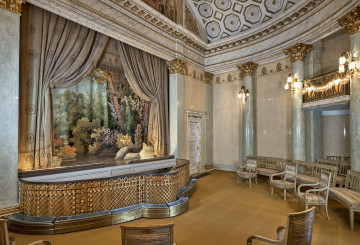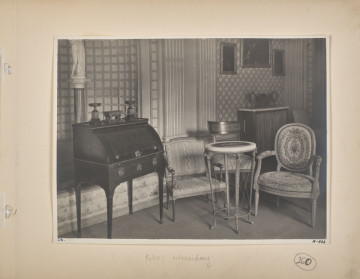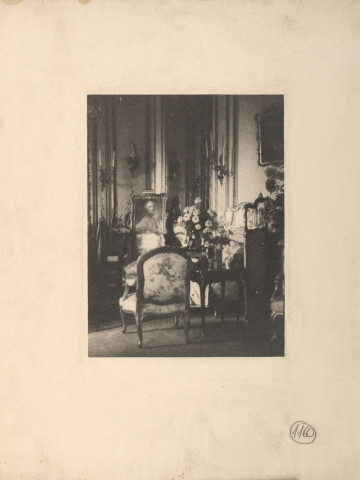
Theatre Hall (Theatre)
Castle Museum in Łańcut
Part of the collection: Interiors
Historical names: “Salle” (approx. 1780); “Gala Room” (1802); “Gala Assembly Room” (1805); “Gala Room, i.e. Ballroom” (1854); “Ballroom” (1880s, 1933).
Time of establishment: 1629-1642 (?); to the end of the 18th century: unidentified interior design; 1800-1801: preserved interior design; renovated in the 19th/ 20th century.
Architects: Chrystian Piotr Aigner (1800 – 1805); Amand Luis Bauqué, Albert Pio (beginning of the 20th century).
Artists: Fryderyk Bauman (1801, stucco work); Karol Chodziński and Jan Ciążyński (1830s, floor).
Description:
The Ballroom is on the first floor in the representative western enfilade of the castle. This is the largest room in the Łańcut residence. Its beginnings probably date back to the time of construction of the “palazzo in fortezza” between 1629 and 1642; however, the details of the interior design prior to 1800 remain unknown.
During the time of Izabela née Czartoryska and Stanisław Lubomirski, a representative “Salle” existed in the place of the Ballroom, as testified by the outline of the first floor of the castle of 1780; its surface area corresponded to the present-day interior (The Ballroom). The “Salle” had six window axes set in pairs in the western façade and the same number of niches in the eastern wall. In one of them, an entrance to the southern single-bay “Gallerie” (Sculpture Gallery) was placed. The corners of the rectangular room were levelled and in the south-western corner, there was a passage to the “puntone” (one of four corner towers). The southern external wall was blind; fireplaces were set inside, along its axis, and opposite in the northern wall. The main entrance to the “Salle” led through two sets of doors from the north from the former Gala Corridor (after 1688 separated into the “Grande Anti Chambre” and the “Vestibulle”). After 1780, the passage from the “Vestibulle” (Room under the Vault) was removed.
As a result of modernisation of the Łańcut residence by the last members of the Lubomirski family, continued by Izabela Lubomirska also after her husband’s death in 1783 and after her return from abroad in 1791, the former “Salle” was transformed. The interior design was prepared by Chrystian Piotr Aigner ca. 1800 and decorated with stuccoes by Fryderyk Bauman who worked in Łańcut since 1801. In the inventory of 1802, the newly equipped “Gala Room”, taking up the first and the second floor of the castle, was decorated with “yellow mosaic surrounded with stuccoes.” In 1805, it was described as the “Gala Assembly Room” which had “yellow mosaic panels and stucco cornices.” In one of the niches in the eastern wall, an additional passage to the Theatre Room was made; the Theatre Room was added at the courtyard by the southern wing after 1780 (1st half of the 1780s). The passage to the tower was removed and only the diagonal cut of the wall in the south-western corner was left; the remaining corners had straight angles. In the southern wall, two doors leading to the newly constructed “Dining Room” were made.
After Izabela Lubomirska’s death in 1816, when the Łańcut castle became the property of her grandson Alfred I Potocki and later his son Alfred II, small changes were made in the design of the “Gala Room” i.e. the “Ballroom.” Four preserved doors (north, south) date back to 1836, one of them is blank. They are made of ash and nut wood, varnished with ebony and decorated with bronze knockers. In the 1830s, a floor designed by Karol Chodziński and executed by carpenter Jan Ciążyński was also made of oak, mahogany, sycamore and ash.
A concise description of the “Ballroom” was prepared in the 1850s. “The Ballroom has the height of two floors ˗ Mosaic walls ˗ Floor made of large sheets of various types of wood. Four double-winged mahogany doors with knockers ˗ six blank doors with mirrors, two of which can be opened ˗ six semicircular windows with blinds ˗ at the top smaller by half, six of which are glazed and ten of which are blank with mirrors in four panels ˗ two chimneys lined with copper in the frames and decorated with marble.” Four large mirrors with “wooden frames with stuccoes” were placed above the fireplaces. Elżbieta née Radziwiłł, Roman Potocki’s wife, recollected that in 1885, the Ballroom was empty.
After Alfred II’s death in 1889, during a reconstruction of the palace carried out for Elżbieta and Roman Potocki between 1889 and 1912, according to the designs of Amand Luis Bauqué and Albert Pio, the Ballroom was renovated. Its two-storey interior is decorated with stuccoes, while the wall surfaces are filled with plain fields of coloured and marbled stucco. A clear architectural division is designated by the pattern of two rows of western windows, blank windows and mirrored doors placed in front of them (with the exception of the actual door to the Theatre and the Sculpture Gallery). The symmetry of the northern and southern wall is emphasised by fireplaces from approx. 1800 (with mirrors in hoods) and doors placed on the sides, with lintels topped with cornices and stucco decoration in the overdoors. In the horizontal division of the interior, the frieze separating the storeys with the motive of griffins in the antithetic pattern and topped with a palmette ornament on a prominent moulding forms a strong accent. In the entablature crowning the wall, the cornice on acanthus corbels was highlighted. The surface of the ceiling, framed with a row of coffers and stucco rosettes, was divided into three fields. In the central one, the largest, with clearly separated corners, sky with clouds was painted; in the outer ones, separated by moulding, there are symmetrical floral patterns, while the framing separating the fields is filled with meanders. The stucco decorations portray the vast richness of ornaments characteristic for mature Classicism. Out of five chandeliers in the room, the central one is from the first half of the 19th century, while the remaining ones were purchased in Paris by Roman Potocki at the end of the 19th century.
Primary references:
• Kossakowska – Szanajca Zofia, Majewska – Maszkowska Bożena, Zamek w Łańcucie, Warsaw 1964.
• Majewska ˗ Maszkowska Bożena, Mecenat artystyczny Izabelli z Czartoryskich Lubomirskiej, Warsaw 1976.
• Omilanowska Małgorzata, Jakub Sito, Łańcut i okolice, [in]: Katalog Zabytków Sztuki w Polsce, Instytut Sztuki PAN, Warsaw 1994.
• Potocka Elżbieta, Łańcut ˗ wspomnienia od roku 1885 do roku 1915, [Pamiętnik, maszynopis w zbiorach Muzeum-Zamek w Łańcucie].
• Piotrowski Józef, Zamek w Łańcucie, Lviv 1933.
Prepared by:
Teresa Bagińska-Żurawska https://orcid.org/0000-0002-9243-3967
Faustyna Bożętka
Object type
Interiors
Creation / finding place
Owner
Castle Museum in Łańcut
Identification number
Location / status

Castle Museum in Łańcut

20th century
Castle Museum in Łańcut

20th century
Castle Museum in Łańcut
DISCOVER this TOPIC
Museum of King Jan III's Palace at Wilanów
DISCOVER this PATH
Educational path